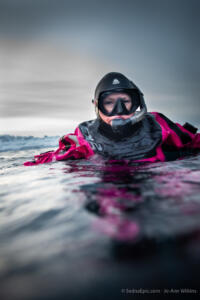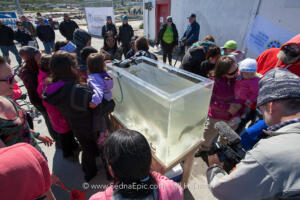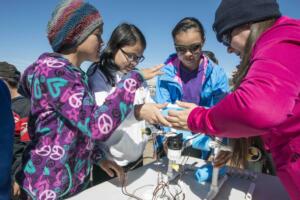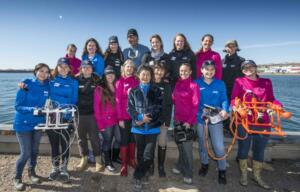NAPEG is pleased to share this feature on member Susan R. Eaton, P.Geol., P. Geoph., in celebration of Engineering and Geoscience Month in Canada, and in recognition of International Women’s Day and of all women in these fields who contribute to communities in the North and across Canada.
“Infinitely Curious” Susan R. Eaton Rewrites STEM Possibilities for Women in the North
Susan R. Eaton works in sectors with professional designations galore, but none of them fully capture her scope.
Based in Yellowknife and licensed through the Northwest Territories and Nunavut Association of Professional Engineers and Geoscientists (NAPEG) as a geologist (P.Geol.) and geophysicist (P.Geoph.), she’s also a journalist, environmentalist, former vice president of three junior oil and gas companies, corporate communicator, polar expedition leader and women’s advocate.

Portrait of Sea Women Expeditions’ Founder & Leader Susan R. Eaton during an ocean research and winter snorkel expedition at 70 degrees North Latitude, Arctic Norway, 2019
Photo by Jo-Ann Wilkins and Courtesy of Jo-Ann Wilkins
“People ask what I am, and I say I’m all of these things,” Eaton shares. “My career represents a continuum of my skills and experiences.”
Five years ago, Eaton moved North of 60, following her keen interest to live and work in the North. Since then, she’s worked in communications for Parks Canada in Fort Smith, as the director of communications for an Inuit-owned marketing and advertising firm in Iqaluit, and as an environmental coordinator for Environment and Climate Change Canada in Yellowknife.
Her career in the North, however, includes three decades of working across the three northern territories, exploring for oil and gas and working for a federal oil and gas regulator. During the past decade, she has led teams of Indigenous and non-Indigenous women on ocean research and scuba diving expeditions to scout, record, and document a warming Arctic.
Eaton holds a B.Sc. Hon. in hard rock geology and biology from Dalhousie University. She also holds a M.Sc.in petroleum geology, with a geophysics specialization, from University of London (Imperial College London, Royal School of Mines). Uniquely equipped with a B.J. (Journalism) Hon. from Carleton University, she writes about science and technology, business, energy, natural resources, the environment, water, space, and adventure travel.

Sea Women Expeditions Mobile Touch Tanks Temporarily House Fishes and invertebrates, allowing interactive ocean learning experiences for Inuit Youths in Nain, Nunatsiavut, 2014
Photo by Jill Heinerth
Photo Courtesy of Sea Women Expeditions
Her expansive view of her career is a reflection of her broader vision of the natural world – and how humans, especially Indigenous women and girls of the North are at the nexus of a changing climate, life, gender equity, culture, food security, and sovereignty.
“Geology informs biology. The reason that certain plants and animals live here (or there) is because of the rock substrate and the type of soil that it generates. Bird colonies are located on steep rocky cliffs beside the ocean because the topography of the sea floor creates the upwelling of nutrients and abundance of food.” Adds Eaton, “There’s a continuum in life and in nature, and I don’t like to compartmentalize. I don’t compartmentalize people either.”
Named as one of Canada’s 100 Greatest Modern-Day Explorers and Trailblazers by the Royal Canadian Geographical Society in 2015 and one of The 50 People Changing the World Who You Should Know About by The Explorers Club in 2021, Eaton continues to push the expeditionary boundaries of circumpolar ocean research, and women in STEM as the founder and leader of Sea Women Expeditions. This social enterprise’s mission is to study disappearing sea ice in the Arctic, creating opportunities for Indigenous and non-Indigenous women to participate in polar exploration and ocean science.

Sea Women Expeditions’ Robot-Building Camp for Inuit and Northern Girls and Youths, Iqaluit, Nunavut, 2016
Photo by Amanda Cotton
Photo courtesy of Sea Women Expeditions
“Physics and geophysics are more technical and math-oriented than other sciences, and we see fewer women entering these disciplines,” Eaton explains. “Girls excel in science in elementary and middle schools, but research shows that they are dropping out of math and science by high school.”
She believes in the importance of engaging girls and students by showcasing role models of women in science and Elders bringing Indigenous Traditional Knowledge (TK) in the classroom. “Diversity, equity and inclusion are extremely important,” she says. “Representation is vitally important.”
A key part of Eaton’s Sea Women Expeditions, Indigenous advisors and participants help shape and lead their innovative ocean knowledge sharing and mobilization program, which has reached more than 1,000 Inuit girls, and youths and Elders in Nunatsiavut, Nunavut and Greenland.
Focusing on Indigenous women and girls in circumpolar communities is central to her Arctic ocean research and dive and snorkel expeditions, Eaton says, because they are the future leaders of the North. “These are matriarchal societies and women are the glue that binds these northern communities. Giving Indigenous women and girls, non-binary, two-spirit and gender diverse people the opportunity to conduct ocean science and to participate in leadership programs creates a ripple effect.”

Sea Women Expeditions’ Robot-Building Day during Ocean Mentorship Program for Inuit and Northern Women, ages 16 to 24 Years, Iqaluit, Nunavut, 2016.
Photo by Amanda Cotton
Photo courtesy of Sea Women Expeditions
Eaton prefers the acronym STEAM over STEM, with an “A” for the Arts because it engages and includes children, women and people who have traditionally been excluded from math and sciences. “With STEAM programs, everyone is involved. During our Arctic expeditions, scientists are doing art and artists are doing science. Everyone brings different tools and skills to the table to talk about ocean change, climate change and women’s leadership issues.”
Eaton gives the example of a former Sea Women Expedition member in 2022 who was a Cirque du Soleil acrobat, now studying earth sciences in her 30s and is training astronauts in movement. “An acrobat who becomes an astronaut, now that’s something,” she happily muses.
That transformation is just one example of how Eaton is helping to rewrite the possibilities women see for themselves and their careers – and the positive impact they can have on the planet and each other.
In another example, Eaton combined her mining background and communications skills to lead a team of eight professionals in 2021 (two technical writers, an Inuit storyteller, a graphic designer, a children’s book illustrator, a science educational consultant, and two Inuktitut translators) to create a five-part reading series for the NWT & Nunavut Chamber of Mines in Iqaluit. Translated into Inuktitut, these illustrated fiction and non-fiction books introduced Grade 3-12 students to the geology of Nunavut and careers in the mining sector. These books showcased Inuit women in non-traditional roles such as geologists, archeologists, and mine haul truck drivers.
“I ended up where I am today because I’m infinitely curious about the world,” she says. “I moved to the North five years ago so I could have a better understanding of the issues facing the North. I’d like to see more Indigenous women sitting at the policy table, influencing and leading future decisions.”
Written by Kailey Morin, Writer + Communications Consultant
In collaboration with Susan R. Eaton, P.Geol., P. Geoph.

